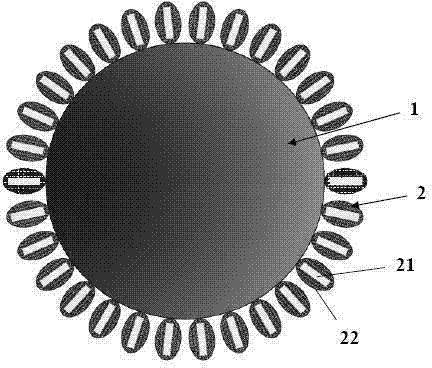Anode active material of lithium ion battery, preparation method thereof and lithium ion battery
A negative electrode active material, lithium ion battery technology, applied in battery electrodes, secondary batteries, circuits, etc., can solve problems such as poor cycle performance of negative electrode active materials, and achieve the effects of improving cycle performance, avoiding volume changes, and preventing agglomeration
- Summary
- Abstract
- Description
- Claims
- Application Information
AI Technical Summary
Problems solved by technology
Method used
Image
Examples
preparation example Construction
[0035] The present invention also provides a preparation method for the above-mentioned negative electrode active material. First, the outer surface of the first material is made of a composite body coated with the second material, and then the composite body is distributed on the surface of the carbon material. A method is prepared, for example, may specifically include the following steps.
[0036] Step 1. In a polytetrafluoroethylene-lined high-pressure reactor, add distilled water and transition metal salts in sequence, and stir to form a uniform solution; add the dispersant under strong stirring; then add the first material, and add the promoter under continuous stirring Then, add an appropriate amount of distilled water to keep the filling degree of the reactor at 60%-95%, seal it, heat it up to 110-200°C under continuous stirring, and keep it at a constant temperature for 12-24h to obtain a precursor suspension, which is filtered , washing, and drying, the obtained soli...
Embodiment 1
[0056] (1) Composite material preparation:
[0057] A. In a polytetrafluoroethylene-lined autoclave, add 2000g of distilled water and 20g of cobalt chloride hexahydrate, and stir to form a uniform solution; then add 10g of polyethylene glycol 6000 dispersant under strong stirring; then add 100g Nano-silica powder (median particle size is 50nm), add 15g of ammonium oxalate under continuous stirring; then, add appropriate amount of distilled water to keep the filling degree of the reactor at 80% and seal, heat up to 180°C under continuous stirring, and keep at constant temperature for 24h, to obtain The precursor suspension was filtered, washed and dried, and the resulting solid was placed in a box furnace at 400°C and calcined in an air atmosphere for 6 hours to obtain a nano-silicon-cobalt tetroxide composite material;
[0058] B. Add 900g graphite and 120g nano-silicon-cobalt tetroxide composite material to 2000g organic solvent mixed with acetone and tetrahydrofuran (ratio 1...
Embodiment 2
[0064] Composite materials, button batteries and full batteries were prepared in the same manner as in Example 1, except that copper chloride hexahydrate was used to replace cobalt chloride hexahydrate, ammonium oxalate was replaced by ammonia water, and the amount of copper chloride dihydrate added was 15 g , the amount of ammonia water added is 10g, keep the filling degree of the reactor at 90%, raise the temperature to 120°C under continuous stirring, and keep at constant temperature for 12h to obtain the precursor suspension. After filtering, washing and drying, the obtained solid is placed in the box Calcined in an argon atmosphere at 400°C for 6 hours in a type furnace to obtain a composite material S2 whose outermost layer is copper oxide;
[0065] According to the same method as in Example 1, button battery A2 and full battery B2 were produced respectively.
PUM
| Property | Measurement | Unit |
|---|---|---|
| Average particle diameter | aaaaa | aaaaa |
| The average diameter | aaaaa | aaaaa |
| Length | aaaaa | aaaaa |
Abstract
Description
Claims
Application Information
 Login to View More
Login to View More - Generate Ideas
- Intellectual Property
- Life Sciences
- Materials
- Tech Scout
- Unparalleled Data Quality
- Higher Quality Content
- 60% Fewer Hallucinations
Browse by: Latest US Patents, China's latest patents, Technical Efficacy Thesaurus, Application Domain, Technology Topic, Popular Technical Reports.
© 2025 PatSnap. All rights reserved.Legal|Privacy policy|Modern Slavery Act Transparency Statement|Sitemap|About US| Contact US: help@patsnap.com


